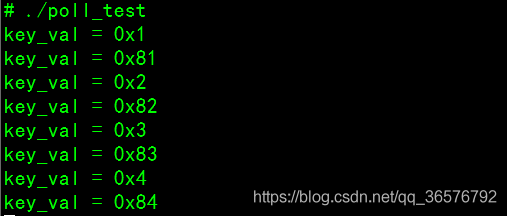五、Linux驱动之poll机制
上一小节写到的中断方式获取按键值时,应用程序需要不停的查询,占用CPU资源太多,现在改用poll机制实现相同的按键效果。
1. poll机制流程
当应用程序调用poll函数的时候(比如:poll(fds,1,5000),fds是定义的一个poll类型的结构体),poll是一个系统调用,会调用到内核入口函数sys_poll(可在内核中找到该函数),该函数最终会调用do_poll函数,do_poll函数中有一个死循环,在里面又会利用do_pollfd()函数去调用驱动中file_operations里的.poll函数。do_poll函数流程代码如下:
do_poll(...)
{
for (;;)
{
set_current_state(TASK_INTERRUPTIBLE); //设置当前任务状态为TASK_INTERRUPTIBLE
...
for()
{
if(do_pollfd(pfd, pt)) //会调用到内核里file_operations里的.poll函数
{
count++;
pt = NULL;
}
}
...
if(count || !*timeout || signal_pending(current))
break;
...
__timeout = *timeout;
*timeout = 0;
...
__timeout= schedule_timeout(__timeout); // 休眠时间从应用程序传入
...
*timeout += __timeout;
...
}
__set_current_state(TASK_RUNNING); //设置当前任务状态为TASK_INTERRUPTIBLE
return count;
} 当进入do_poll()死循环函数时,首先设置当前进程为TASK_INTERRUPTIBLE状态(该状态下的进程如果休眠的话可以被信号和wake_up()唤醒),然后执行到第一个if()语句do_pollfd(pfd, pt),里面实际调用到对应驱动设备里file_operations里的.poll函数,该函数又会调用poll_wait()函数将该进程加入休眠队列(此时没有进入休眠)。
驱动程序里的poll函数此时应该返回给if()函数为0,不执行if()语句里的内容,继续往下执行,第二个if()的3个判断条件都不满足所以也不执行break,最后调用schedule_timeout()这个休眠函数,进入休眠。
接下来可能有两种情况:
(1) 超时退出休眠
程序调用schedule_timeout()进行休眠的时间到了,schedule_timeout()返回0,重新开始死循环,跑到第二个if()语句时满足判断条件*timeout为0,执行break退出死循环。调用poll系统调用的的应用程序继续往下执行。
(2) 被wake_up()唤醒休眠
在schedule_timeout()休眠时间没到时被wake_up()唤醒,此时重新执行for死循环,当循环到第一个if()语句时,do_pollfd(pfd, pt)函数(也就是驱动中file_operations里的.poll函数)如果返回非0值,满足条件执行count++,当执行到下一个if()语句也就满足条件执行break退出死循环。调用poll系统调用的的应用程序继续往下执行。
因此,我们还知道应用程序调用poll有两种返回值,返回的count为1时表示对应驱动设备里file_operations里的.poll函数返回非0值,返回值为0时表示count并没有自增而是超时时间到了才退出死循环的)。当驱动程序没写.poll函数时,应用程序也能调用系统调用poll函数,此时只充当简单的延时作用。
2. 编写代码
驱动程序poll_drv.c完整代码如下:
#include
#include
#include
#include
#include
#include
#include
#include
#include
#include
#include
#include
#include
int major;
static struct cdev button_cdev;
static struct class *button_class;
volatile unsigned long *gpfcon;
volatile unsigned long *gpfdat;
volatile unsigned long *gpgcon;
volatile unsigned long *gpgdat;
static DECLARE_WAIT_QUEUE_HEAD(button_waitq);
/* 中断事件标志, 中断服务程序将它置1,forth_drv_read将它清0 */
static volatile int ev_press = 0;
struct pin_desc{
unsigned int pin;
unsigned int key_val;
};
/* 键值: 按下时, 0x01, 0x02, 0x03, 0x04 */
/* 键值: 松开时, 0x81, 0x82, 0x83, 0x84 */
static unsigned char key_val;
struct pin_desc pins_desc[4] = {
{S3C2410_GPF0, 0x01},
{S3C2410_GPF2, 0x02},
{S3C2410_GPG3, 0x03},
{S3C2410_GPG11, 0x04},
};
/*
* 确定按键值
*/
static irqreturn_t buttons_irq(int irq, void *dev_id)
{
struct pin_desc * pindesc = (struct pin_desc *)dev_id;
unsigned int pinval;
pinval = s3c2410_gpio_getpin(pindesc->pin);
if (pinval)
{
/* 松开 */
key_val = 0x80 | pindesc->key_val;
}
else
{
/* 按下 */
key_val = pindesc->key_val;
}
ev_press = 1; /* 表示中断发生了 */
wake_up_interruptible(&button_waitq); /* 唤醒休眠的进程 */
return IRQ_RETVAL(IRQ_HANDLED);
}
static int button_open(struct inode *inode, struct file *file)
{
/* 配置GPF0,2为输入引脚 */
/* 配置GPG3,11为输入引脚 */
request_irq(IRQ_EINT0, buttons_irq, IRQT_BOTHEDGE, "S2", &pins_desc[0]);
request_irq(IRQ_EINT2, buttons_irq, IRQT_BOTHEDGE, "S3", &pins_desc[1]);
request_irq(IRQ_EINT11, buttons_irq, IRQT_BOTHEDGE, "S4", &pins_desc[2]);
request_irq(IRQ_EINT19, buttons_irq, IRQT_BOTHEDGE, "S5", &pins_desc[3]);
return 0;
}
ssize_t button_read(struct file *file, char __user *buf, size_t size, loff_t *ppos)
{
int result;
if (size != 1)
return -EINVAL;
/* 如果没有按键动作, 休眠 */
wait_event_interruptible(button_waitq, ev_press);
/* 如果有按键动作, 返回键值 */
result=copy_to_user(buf, &key_val, 1);
ev_press = 0;
return result;
}
int button_close(struct inode *inode, struct file *file)
{
free_irq(IRQ_EINT0, &pins_desc[0]);
free_irq(IRQ_EINT2, &pins_desc[1]);
free_irq(IRQ_EINT11, &pins_desc[2]);
free_irq(IRQ_EINT19, &pins_desc[3]);
return 0;
}
static unsigned button_poll(struct file *file, poll_table *wait)
{
unsigned int mask = 0;
poll_wait(file, &button_waitq, wait); // 不会立即休眠
if (ev_press)
mask |= POLLIN | POLLRDNORM;
return mask;
}
static struct file_operations button_fops = {
.owner = THIS_MODULE, /* 这是一个宏,推向编译模块时自动创建的__this_module变量 */
.open = button_open,
.read = button_read,
.release = button_close,
.poll = button_poll,
};
static int button_init(void)
{
int result;
dev_t devid = MKDEV(major, 0); //从主设备号major,次设备号0得到dev_t类型
if (major)
{
result=register_chrdev_region(devid, 1, "button"); //注册字符设备
}
else
{
result=alloc_chrdev_region(&devid, 0, 1, "button"); //注册字符设备
major = MAJOR(devid); //从dev_t类型得到主设备
}
if(result<0)
return result;
cdev_init(&button_cdev, &button_fops);
cdev_add(&button_cdev, devid, 1);
button_class = class_create(THIS_MODULE, "button_drv");
class_device_create(button_class, NULL, MKDEV(major, 0), NULL, "buttons"); /* /dev/buttons */
gpfcon = (volatile unsigned long *)ioremap(0x56000050, 16);
gpfdat = gpfcon + 1;
gpgcon = (volatile unsigned long *)ioremap(0x56000060, 16);
gpgdat = gpgcon + 1;
return 0;
}
static void button_exit(void)
{
class_device_destroy(button_class, MKDEV(major, 0));
class_destroy(button_class);
cdev_del(&button_cdev);
unregister_chrdev_region(MKDEV(major, 0), 1);
iounmap(gpfcon);
iounmap(gpgcon);
return 0;
}
module_init(button_init);
module_exit(button_exit);
MODULE_LICENSE("GPL");
应用程序poll_test.c完整代码如下:
#include
#include
#include
#include
#include
int main(int argc, char **argv)
{
int fd;
unsigned char key_val;
int ret;
struct pollfd fds[1];
fd = open("/dev/buttons", O_RDWR);
if (fd < 0)
{
printf("can't open!\n");
}
fds[0].fd = fd;
fds[0].events = POLLIN;
while (1)
{
ret = poll(fds, 1, 5000);
if (ret == 0)
{
printf("time out\n");
}
else
{
read(fd, &key_val, 1);
printf("key_val = 0x%x\n", key_val);
}
}
return 0;
}
Makefile如下:
KERN_DIR = /work/system/linux-2.6.22.6 //内核目录
all:
make -C $(KERN_DIR) M=`pwd` modules
clean:
make -C $(KERN_DIR) M=`pwd` modules clean
rm -rf modules.order
obj-m += poll_drv.o3. 测试
内核:linux-2.6.22.6
编译器:arm-linux-gcc-3.4.5
环境:ubuntu9.10
将button_drv.c、button_test.c、Makefile三个文件放入网络文件系统内,在ubuntu该目录下执行:
make
arm-linux-gcc -o poll_test poll_test.c
在挂载了网络文件系统的开发板上进入相同目录,执行“ls”查看:
装载驱动:
insmod poll_drv.ko
运行测试程序:
./poll_test
按下开发板的4个按键,结果如下:
长时间未操作,会打印time_out.
4. 程序说明
当执行应用程序时,首先打开/dev/buttons设备,接着进入死循环调用poll(fds, 1, 5000)(第三个参数为休眠时间5秒),系统调用sys_poll最后调用到do_poll函数(死循环函数)里陷入休眠(休眠前先执行了一次驱动里的button_poll函数),当有按键按下时,调用wake_up_interruptible()唤醒休眠,重新循环执行do_poll函数第一个if()函数的判断语句,此时button_poll函数返回非0值,执行count++,再往下执行第二个if()语句break退出循环(即退出应用程序里的poll(fds, 1, 5000)),此时再将键值读出来。当5秒内没有操作按键时,也会退出poll(fds, 1, 5000),打印time_out。
5. 知识点
poll相关函数
与.write、.read、.open等函数一样,需要在file_operations里面填充.poll = button_poll,,在button_poll函数里面需要调用poll_wait,函数原型如下:
static inline void poll_wait(struct file * filp, wait_queue_head_t * wait_address, poll_table *p);
参数:
filp:设备文件信息的 struct file 结构体的指针参数。
wait_address:等待队列头。
p:追加到设备驱动上的 poll_table结构体指针参数。
调用完该函数时,进程并没有立即进入休眠,只是将进程加入wait_address队列。
PS:wake_up的参数就是想要唤醒的队列,这里就是poll_wait传入的队列。